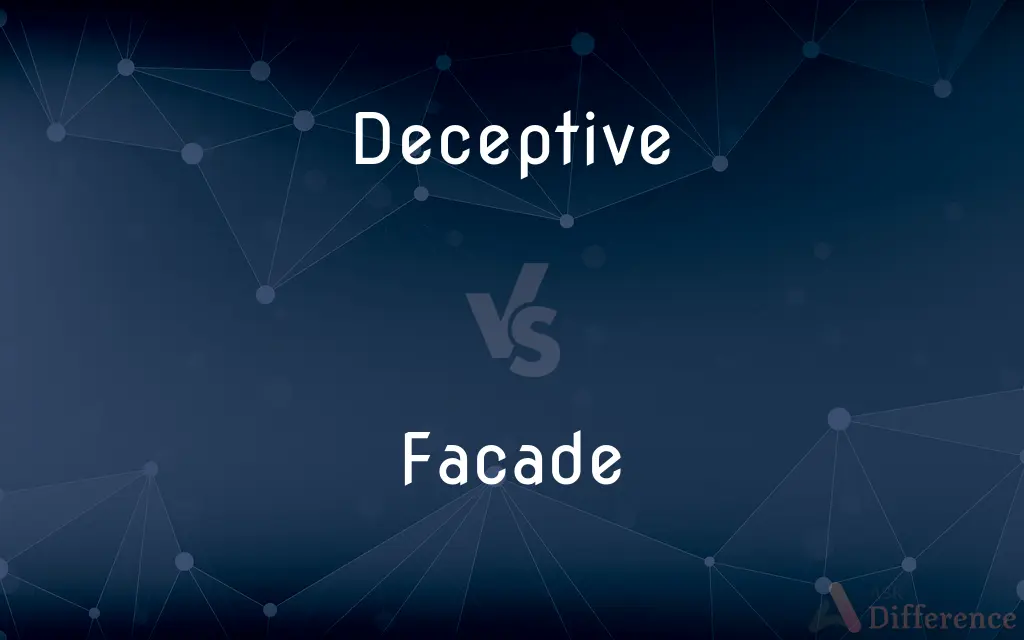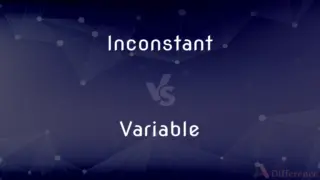Deceptive vs. Facade — What's the Difference?
By Urooj Arif & Maham Liaqat — Updated on March 20, 2024
Deceptive refers to the act of misleading or causing someone to believe something that is not true, while a facade is a superficial appearance or illusion maintained to conceal a less pleasant reality.

Difference Between Deceptive and Facade
Table of Contents
ADVERTISEMENT
Key Differences
Deceptive is an adjective describing actions, behaviors, or characteristics intended to deceive or mislead others, suggesting dishonesty or manipulation to hide the truth or create a false impression. In contrast, a facade is a noun that often refers to a physical front of a building designed to be impressive, but by extension, it is used metaphorically to describe any superficial appearance or pretense put up to hide the true nature or state of something.
While deceptive behaviors are actively misleading, involving trickery or falsehoods, a facade might not involve active deception but rather the maintenance of an outward appearance that belies the underlying reality. For example, someone might put up a cheerful facade to hide their sadness without actively deceiving others about specific facts.
Deceptive actions are generally considered unethical or morally questionable because they involve intentional deceit. In contrast, maintaining a facade can be seen as a protective measure or a social strategy, not always with the intent to deceive but sometimes to adhere to social norms or personal privacy.
The concept of being deceptive inherently involves an element of intentionality to mislead, which can occur in various contexts, from personal relationships to advertising. A facade, however, especially when used metaphorically, often relates to emotional or psychological aspects of concealing one's true feelings or the true state of affairs.
Comparison Chart
Nature
Adjective describing misleading or dishonest actions.
Noun referring to a superficial appearance or front.
ADVERTISEMENT
Intent
Intentionally causing someone to believe something false.
Maintaining an outward appearance that may conceal the true nature.
Ethical Connotation
Generally negative, associated with dishonesty.
Can be neutral or negative, depending on context.
Usage Context
Actions, behavior, or characteristics aimed at deceiving.
Often used to describe emotional or psychological fronts, as well as physical fronts of buildings.
Example
A deceptive advertisement misleads consumers about the product's benefits.
A person might put up a brave facade to hide their inner turmoil.
Compare with Definitions
Deceptive
Intended to mislead or trick.
The deceptive scheme was designed to defraud investors.
Facade
A superficial appearance or illusion maintained to conceal a less pleasant reality.
Beneath his cheerful facade, he was deeply troubled.
Deceptive
Giving an appearance or impression different from the true one.
The calm surface of the water was deceptive; strong currents lurked below.
Facade
A way of behaving that hides one's true feelings.
She maintained a facade of indifference, though she was hurt.
Deceptive
Involving the distortion of truth.
Deceptive advertising practices can lead to legal consequences.
Facade
The front of a building, especially one that is imposing or decorative.
The building's facade was renovated to restore its historic charm.
Deceptive
Characterized by dishonesty or falsehood.
He had a deceptive charm that masked his true intentions.
Facade
A false appearance or way of behaving that hides what someone or something is really like.
The company's friendly facade hid a cutthroat corporate culture.
Deceptive
Relating to actions that cause someone to accept as true what is false.
Her deceptive tactics in the negotiation were later revealed.
Facade
Any side of a building facing a public way or space.
The new library's facade blends modern and traditional architectural elements.
Deceptive
Deceiving or tending to deceive
A deceptive advertisement.
Facade
The face of a building, especially the principal face.
Deceptive
Likely or attempting to deceive.
Deceptive practices
Appearances can be deceptive.
Facade
An artificial or deceptive front
Ideological slogans that were a façade for power struggles.
Deceptive
Tending to deceive; having power to mislead, or impress with false opinions; as, a deceptive countenance or appearance.
Language altogether deceptive, and hiding the deeper reality from our eyes.
Facade
(architecture) The face of a building, especially the front view or elevation.
Deceptive
Causing one to believe what is not true or fail to believe what is true;
Deceptive calm
A delusory pleasure
Facade
(by extension) The face or front (most visible side) of any other thing, such as an organ.
Deceptive
Tending to deceive or mislead either deliberately or inadvertently;
The deceptive calm in the eye of the storm
Deliberately deceptive packaging
A misleading similarity
Statistics can be presented in ways that are misleading
Facade
(figuratively) A deceptive or insincere outward appearance.
Facade
(programming) An object serving as a simplified interface to a larger body of code, as in the facade pattern.
Facade
The front of a building; esp., the principal front, having some architectural pretensions. Thus a church is said to have its façade unfinished, though the interior may be in use.
Facade
The face or front of a building
Facade
A showy misrepresentation intended to conceal something unpleasant
Common Curiosities
Is it always wrong to maintain a facade?
Maintaining a facade is not always ethically wrong; it can be a means of coping, privacy protection, or adhering to social norms, depending on the context and intention.
How can one recognize deceptive behavior?
Recognizing deceptive behavior often involves noticing inconsistencies, factual inaccuracies, or behaviors that seem designed to mislead or manipulate.
What is the difference between being deceptive and having a facade?
Being deceptive involves intentional deceit, whereas having a facade relates to maintaining an outward appearance that may not reflect the inner reality, not always with the intent to deceive.
What makes an action deceptive?
An action is deceptive if it intentionally misleads or causes someone to believe something untrue.
Can a business have a deceptive facade?
A business can have a deceptive facade if it presents an outward image or branding that significantly misrepresents the reality of its products, services, or corporate practices.
How can deceptive practices affect relationships?
Deceptive practices can severely damage trust and credibility in relationships, leading to conflicts, misunderstandings, and potential dissolution of the relationship.
Why do people create facades?
People create facades for various reasons, including hiding vulnerabilities, conforming to social expectations, or presenting an idealized image to others.
How do cultural norms influence the use of facades?
Cultural norms and expectations can greatly influence the use of facades, as they dictate acceptable behaviors, emotions, and appearances in various social contexts.
Can entire communities or societies maintain a facade?
Communities or societies can maintain a collective facade, often to preserve a certain image, ideology, or to hide systemic issues from outsiders or even themselves.
Is it possible for a facade to become one's true self over time?
Over time, a maintained facade can become integrated into one's identity to some extent, though it may still conceal deeper truths or feelings.
How do personal values affect perceptions of facades and deception?
Personal values and ethics significantly affect how individuals perceive and judge the use of facades and deceptive behaviors, with variations in tolerance and acceptance across different value systems.
Can a facade be unintentional?
A facade, especially in emotional or psychological contexts, can sometimes be unintentional or subconscious, serving as a defense mechanism rather than a deliberate attempt to deceive.
What is the impact of social media on the prevalence of facades?
Social media can amplify the prevalence of facades, as it often encourages the presentation of idealized selves and lifestyles, sometimes at the expense of authenticity.
What role does intent play in determining whether something is deceptive?
Intent is crucial in determining deceptiveness; actions or communications intended to mislead or cause false beliefs are considered deceptive.
Can a well-intentioned action be deceptive?
An action can be deceptive even if well-intentioned, if it involves misleading others or presenting false information, regardless of the motive.
Share Your Discovery

Previous Comparison
Inconstant vs. Variable
Next Comparison
Fortissimo vs. FortississimoAuthor Spotlight
Written by
Urooj ArifUrooj is a skilled content writer at Ask Difference, known for her exceptional ability to simplify complex topics into engaging and informative content. With a passion for research and a flair for clear, concise writing, she consistently delivers articles that resonate with our diverse audience.
Co-written by
Maham Liaqat













































